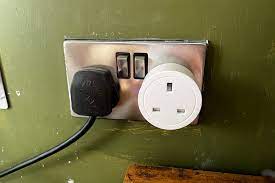Why is My Outlet Not Working and How Can I Fix It?

Last Updated on March 9, 2024 by Ali Hamza
- Understanding the Common Causes of Outlet Failure
- Step by Step Guide to Troubleshooting Outlet Problems
- The Importance of Electrical Safety When Fixing Outlets
- Troubleshooting Outlet Issues: Checking the Circuit Breaker
- The Cost of Replacing and Fixing Outlets: A Budgeting Guide
- Maximizing Outlet Efficiency: Tips for Long-Term Outlet Maintenance
- When to Call an Electrician: Recognizing Outlet Issues Beyond Your Expertise
- The Importance of Electrical Safety When Fixing Outlets
- How to replace a faulty outlet a simple guide
- Conclusion
- Frequently Asked Questions (FAQs)
A non-working electrical outlet can be a major inconvenience, disrupting your daily routines and even putting your safety at risk. If you’re experiencing a problem with an outlet in your home, it’s important to understand the cause of the issue and take the necessary steps to fix it. In this article, we’ll explore the common reasons for a non-working outlet and provide a step-by-step guide for troubleshooting and fixing the problem.
A non-working electrical outlet can be a major inconvenience, disrupting your daily routines and even putting your safety at risk. If you’re experiencing a problem with an outlet in your home, it’s important to understand the cause of the issue and take the necessary steps to fix it. In this article, we’ll explore the common reasons for a non-working outlet and provide a step-by-step guide for troubleshooting and fixing the problem.
Understanding the Common Causes of Outlet Failure
Before you can fix a non-working outlet, it’s important to understand why it’s not functioning properly. Here are some of the most common causes of outlet failure:
Overloaded Circuit
When too many devices are plugged into a single outlet or circuit, it can cause the circuit to overload and trip the circuit breaker, causing the outlet to stop working.
Loose Wiring
Over time, the connections between the outlet and the wiring can become loose, which can cause an interruption in the flow of electricity and result in a non-working outlet.
Damaged Outlet
Outlets can become damaged from wear and tear, or from sudden impact, such as a vacuum cleaner hitting it. This can result in a non-working outlet.
Faulty Wiring
In some cases, the wiring itself may be faulty, causing an interruption in the flow of electricity and resulting in a non-working outlet.
Step by Step Guide to Troubleshooting Outlet Problems
If you’re experiencing a problem with an outlet in your home, follow these steps to troubleshoot the issue
Check the Circuit Breaker
The first step in troubleshooting a non-working outlet is to check the circuit breaker. If the circuit breaker has tripped, simply switch it back to the on position to restore power to the outlet.
Inspect the Wiring and Connections
If the circuit breaker is not the issue, inspect the wiring and connections to ensure they are securely connected to the outlet and the electrical box. If the connections are loose, tighten them.
Check the Outlet
If the wiring and connections appear to be secure, inspect the outlet itself for any visible signs of damage, such as cracks or signs of overheating.
The Importance of Electrical Safety When Fixing Outlets
Electrical safety should always be the top priority when fixing outlets. Working with electrical wiring can be dangerous and even life-threatening if the proper safety procedures are not followed. This is why it is recommended to call a licensed electrician if you’re not comfortable with the task, as they have the experience and expertise to ensure the job is done safely and effectively. To further ensure your safety, make sure to turn off the power supply before starting any work, and to avoid overloading the outlet by only plugging in the recommended amount of electrical devices. By following these simple safety measures, you can keep yourself and your home protected while ensuring your outlets are functioning properly.
It’s important to be mindful of the potential dangers associated with electrical work, especially when fixing outlets. If you’re not comfortable working with electrical wiring, it’s best to call a licensed electrician. This will ensure the safety of you and your home.
Troubleshooting Outlet Issues: Checking the Circuit Breaker
One of the first steps in troubleshooting outlet issues is to check the circuit breaker. A tripped circuit breaker can cause an outlet to stop working, and it’s an easy problem to fix. To check if the circuit breaker is the cause of the issue, locate the circuit breaker box in your home and look for a switch that is in the off position. If you find one, simply switch it back to the on position to restore power to the outlet. It’s important to remember that tripped circuit breakers can also be a sign of an overloaded circuit, so be mindful of the number of electrical devices you have plugged into the outlet. By checking the circuit breaker, you can quickly and easily fix the problem and get your outlet back up and running.
The Cost of Replacing and Fixing Outlets: A Budgeting Guide
The cost of replacing and fixing outlets can vary depending on several factors, including the type of outlet, the extent of the damage, and the cost of labor in your area. However, there are some steps you can take to budget for these costs and make sure you’re prepared. First, research the average cost of the specific type of outlet you need and the cost of labor in your area to get a rough estimate of the cost. Next, consider if you’re comfortable with doing the work yourself or if you need to hire a professional electrician. Doing the work yourself can save you money on labor costs, but it’s important to make sure you have the proper tools and knowledge to complete the job safely. Finally, budget for any additional materials you may need, such as electrical wire, circuit breakers, or wall plates. By considering these factors, you can make a rough estimate of the cost and prepare a budget for replacing and fixing outlets.
Maximizing Outlet Efficiency: Tips for Long-Term Outlet Maintenance
Maximizing outlet efficiency and ensuring long-term outlet maintenance requires a few simple steps. First, avoid overloading the outlet by only plugging in the recommended amount of electrical devices. This helps prevent tripped circuit breakers and potential electrical hazards. Second, keep the outlet and surrounding area clean and free of dust, as this can cause a buildup of heat which can lead to damage. Finally, inspect the outlet periodically for any signs of wear or damage, and replace it if necessary. By following these tips, you can maximize outlet efficiency and keep your outlets functioning properly for years to come. Additionally, regularly scheduling electrical inspections with a licensed electrician can help identify any potential issues before they become bigger problems and ensure the safety and reliability of your electrical system.
When to Call an Electrician: Recognizing Outlet Issues Beyond Your Expertise
Knowing when to call an electrician is crucial in ensuring the safety and proper functioning of your outlets. While some outlet issues can be fixed by troubleshooting and simple repairs, others may require the expertise of a licensed electrician. It’s important to recognize when the issue goes beyond your level of expertise and to seek professional help in such cases. For instance, if you’re experiencing flickering lights, strange odors, sparks, or if the outlet feels hot to the touch, these are all signs of a potentially serious issue and it’s best to call an electrician immediately. In addition, if you’re not comfortable with electrical work or if the issue is beyond your knowledge or ability, it’s always safer to call an electrician. By recognizing when to call an electrician, you can avoid potential electrical hazards and ensure your outlets are functioning properly and safely.
The Importance of Electrical Safety When Fixing Outlets
It’s important to be mindful of the potential dangers associated with electrical work, especially when fixing outlets. If you’re not comfortable working with electrical wiring, it’s best to call a licensed electrician. This will ensure the safety of you and your home.
How to replace a faulty outlet a simple guide
If the outlet is damaged or faulty, the best solution is to replace it. Here’s how to do it:
Turn off the Power
Before you start, turn off the power to the outlet by switching off the circuit breaker or removing the fuse from the fuse box.
Remove the Outlet Cover Plate
Use a screwdriver to remove the screws that hold the cover plate in place, and gently remove the cover plate from the outlet.
Disconnect the Wiring
Carefully disconnect the wires from the outlet by removing the screws that hold the wires in place. Take note of the wire connections so you can properly reconnect them later.
Install the New Outlet
Place the new outlet into the electrical box and reconnect the wires to the new outlet, making sure to connect them in the same order as they were connected to the old outlet.
Conclusion
In conclusion, a non-working outlet can be caused by a variety of factors, including an overloaded circuit, loose wiring, damaged outlet, or faulty wiring. By understanding the common causes of outlet failure and following the steps in our guide, you can troubleshoot and fix the problem yourself. However, it’s important to prioritize safety when working with electrical wiring and to call a licensed electrician if you’re not comfortable with the task. With these tips, you can ensure that your outlets are functioning properly and keep your home powered up and running smoothly.
Frequently Asked Questions (FAQs)
- What are the common causes of a non-working outlet?
The most common causes of a non-working outlet are an overloaded circuit, loose wiring, damaged outlet, or faulty wiring.
- What should I do if my circuit breaker has tripped?
If your circuit breaker has tripped, simply switch it back to the on position to restore power to the outlet.
- Can I fix a non-working outlet myself?
Yes, you can troubleshoot and fix a non-working outlet yourself, but it’s important to prioritize safety and call a licensed electrician if you’re not comfortable with the task.
- What do I need to replace a faulty outlet?
To replace a faulty outlet, you’ll need a new outlet, a screwdriver, and possibly wire connectors, depending on the type of outlet you’re installing.
Apart from this, if you are interested to know more about How To Purchase The Perfect Electric Vehicle Charger? then visit our Business category.



